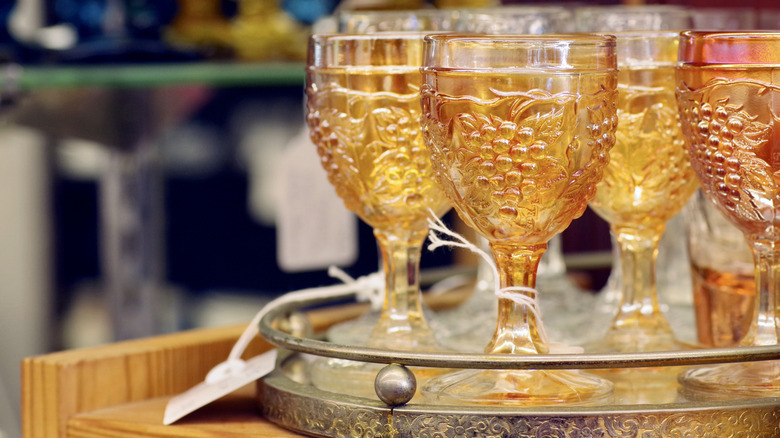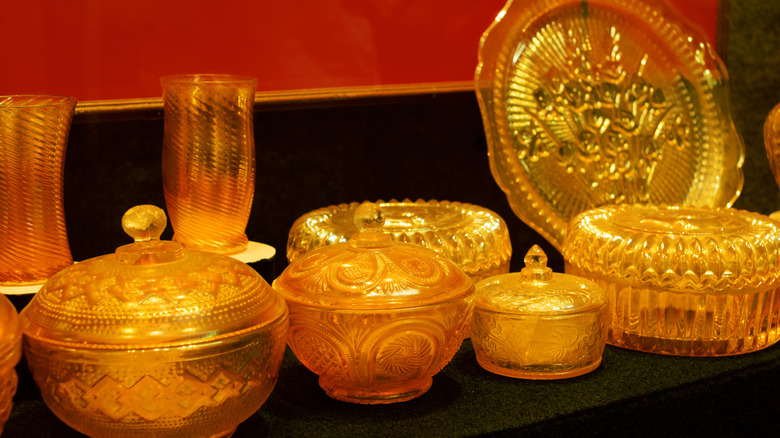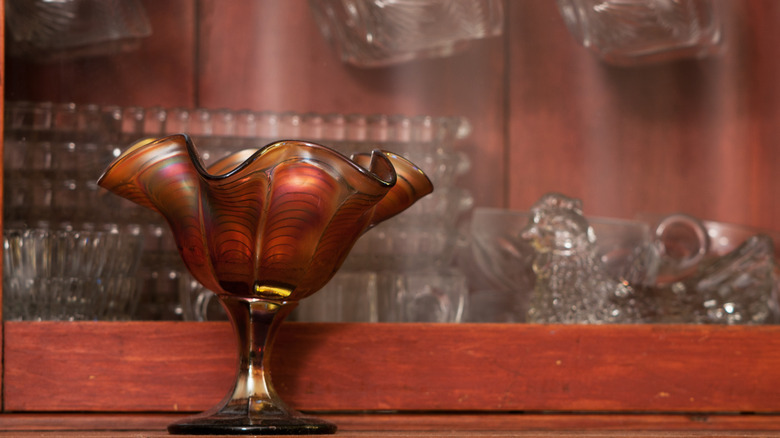Tips & Tricks For Thrifting Authentic Carnival Glass (And Where To Put It In Your Home)
Browsing your local secondhand shop is a great way to score unique, rare, and valuable items at unbelievably low prices. Some used, antique items like glass can add a fun personality to your decor or even sell for thousands of dollars. And the one type that you want to be on the lookout for while thrifting is carnival glass. But fair warning, there are a ton of counterfeits out on the market, trying hard to replicate this vintage beauty. Before you fill up your cart with all the old-fashioned glassware you can find, be aware of tips and tricks for thrifting authentic carnival glass and the best place to put it in your home.
Not only can it bring serious money, but vintage carnival glass is a thrift store find that will help boost your kitchen's aesthetic appeal. Before it became a talking piece in modern homes, carnival glass came about for a functional reason. The glass pieces would naturally sparkle in limited light, which made it a popular American home decor piece in the early 1900s when residential lighting was limited. This type of glassware has a distinct look inspired by natural elements with its flowy or ribbony molded shape and dazzling finish. It comes in a wide range of colors, including marigold, cobalt, and green, and a variety of designs, such as cups, vases, pitchers, punch bowls, and plates.
Check the authenticity of carnival glass with its shape, base, feel, and marking
You think you found carnival glass and now you need to know how to authenticate your latest thrifting find. The first way to know you have true carnival glass is by inspecting the overall piece. Fakes of this vintage glassware will have heavy or bulky bases and a finish or mold pattern that looks either too illuminating or unclear. While touching the glass, check to see if there is any oily residue, which may stick behind if the piece was made in newer molds. Another way to know if you have an older piece is to review the bottom of the base for scratches left behind from years of use.
Very similar to logos, maker marks were placed on the bottom of some of the vintage pieces made by commonly known carnival glass manufacturers, such as Dugan, Fenton, Imperial, and Northwood. Many of these marks were just initials and names, which later transformed into logos like on Fenton pieces. While looking at vintage carnival glass, remember that not all items will have a mark or a logo. That's where knowing the feel and look of the older pieces or getting it professionally appraised at a specialized or antique shop comes in handy. Once you know it is real, you can sell or show off your collection.
Ways to display carnival glass in your home
You may be tempted to eat off some of these lead-free carnival glass pieces like the plates, mugs, and punch bowls, but be wary because some older, specific color items may have uranium in them. Instead, you can integrate them into your home's aesthetic by turning them into centerpieces or displaying them on cabinets, shelves, and walls. Since many of these colorful glassware pieces were made into vases, they can elevate a table in your home as a unique centerpiece. Place a floral arrangement inside of a carnival glass piece, or place the glass item on its own and wait for the compliments to stream in.
Displaying your carnival glass is an innovative way to bring wall art into your kitchen, bar, or dining area. This shiny glassware brings a funky, vibrant look to any home, especially on cabinets, shelves, and walls. If you have a piece with uranium, cabinets work well since you need to keep it away from sunlight and heat. However, this isn't a common ingredient in most vintage pieces, so feel free to place all other carnival glass elsewhere. Shelves, floating shelves, and wall brackets are great ways to show off this iridescent beauty to everyone who comes over. You can even go back to its root and use carnival glass as a statement piece on your fireplace mantel or next to a window.


